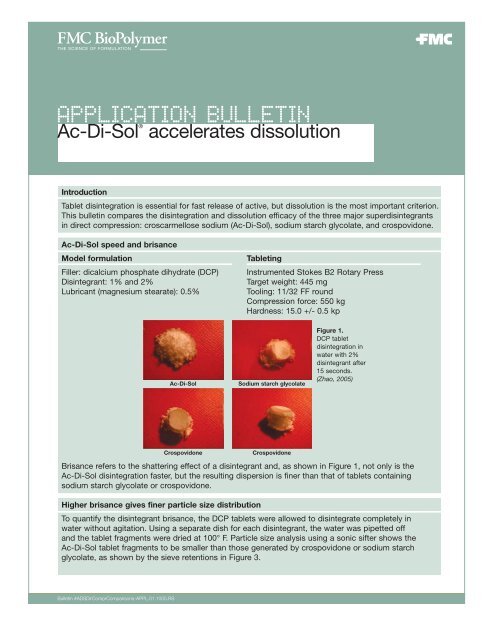Ac-Di-Sol AccelDislove 11x17 - FMC BioPolymer
Ac-Di-Sol AccelDislove 11x17 - FMC BioPolymer Ac-Di-Sol AccelDislove 11x17 - FMC BioPolymer
APPLICATION BULLETINAc-Di-Sol ®accelerates dissolutionIntroductionTablet disintegration is essential for fast release of active, but dissolution is the most important criterion.This bulletin compares the disintegration and dissolution efficacy of the three major superdisintegrantsin direct compression: croscarmellose sodium (Ac-Di-Sol), sodium starch glycolate, and crospovidone.Ac-Di-Sol speed and brisanceModel formulationFiller: dicalcium phosphate dihydrate (DCP)Disintegrant: 1% and 2%Lubricant (magnesium stearate): 0.5%TabletingInstrumented Stokes B2 Rotary PressTarget weight: 445 mgTooling: 11/32 FF roundCompression force: 550 kgHardness: 15.0 +/- 0.5 kpAc-Di-SolSodium starch glycolateFigure 1.DCP tabletdisintegration inwater with 2%disintegrant after15 seconds.(Zhao, 2005)CrospovidoneCrospovidoneBrisance refers to the shattering effect of a disintegrant and, as shown in Figure 1, not only is theAc-Di-Sol disintegration faster, but the resulting dispersion is finer than that of tablets containingsodium starch glycolate or crospovidone.Higher brisance gives finer particle size distributionTo quantify the disintegrant brisance, the DCP tablets were allowed to disintegrate completely inwater without agitation. Using a separate dish for each disintegrant, the water was pipetted offand the tablet fragments were dried at 100° F. Particle size analysis using a sonic sifter shows theAc-Di-Sol tablet fragments to be smaller than those generated by crospovidone or sodium starchglycolate, as shown by the sieve retentions in Figure 3.Bulletin #ADSDirComprComparisons-APPL.01.1005.RS
- Page 2 and 3: Figure 2.Sieve fractions ofdried ta
APPLICATION BULLETIN<strong>Ac</strong>-<strong>Di</strong>-<strong>Sol</strong> ®accelerates dissolutionIntroductionTablet disintegration is essential for fast release of active, but dissolution is the most important criterion.This bulletin compares the disintegration and dissolution efficacy of the three major superdisintegrantsin direct compression: croscarmellose sodium (<strong>Ac</strong>-<strong>Di</strong>-<strong>Sol</strong>), sodium starch glycolate, and crospovidone.<strong>Ac</strong>-<strong>Di</strong>-<strong>Sol</strong> speed and brisanceModel formulationFiller: dicalcium phosphate dihydrate (DCP)<strong>Di</strong>sintegrant: 1% and 2%Lubricant (magnesium stearate): 0.5%TabletingInstrumented Stokes B2 Rotary PressTarget weight: 445 mgTooling: 11/32 FF roundCompression force: 550 kgHardness: 15.0 +/- 0.5 kp<strong>Ac</strong>-<strong>Di</strong>-<strong>Sol</strong>Sodium starch glycolateFigure 1.DCP tabletdisintegration inwater with 2%disintegrant after15 seconds.(Zhao, 2005)CrospovidoneCrospovidoneBrisance refers to the shattering effect of a disintegrant and, as shown in Figure 1, not only is the<strong>Ac</strong>-<strong>Di</strong>-<strong>Sol</strong> disintegration faster, but the resulting dispersion is finer than that of tablets containingsodium starch glycolate or crospovidone.Higher brisance gives finer particle size distributionTo quantify the disintegrant brisance, the DCP tablets were allowed to disintegrate completely inwater without agitation. Using a separate dish for each disintegrant, the water was pipetted offand the tablet fragments were dried at 100° F. Particle size analysis using a sonic sifter shows the<strong>Ac</strong>-<strong>Di</strong>-<strong>Sol</strong> tablet fragments to be smaller than those generated by crospovidone or sodium starchglycolate, as shown by the sieve retentions in Figure 3.Bulletin #ADS<strong>Di</strong>rComprComparisons-APPL.01.1005.RS
Figure 2.Sieve fractions ofdried tablet fragments.(Zhao, 2005)1% Superdisintegrant(>500 ) (>355 )2% Superdisintegrant<strong>Ac</strong>-<strong>Di</strong>-<strong>Sol</strong>Crospovidone (smaller particle size)Sodium starch glycolateCrospovidone (larger particle size)(>500 ) (>355 )<strong>Ac</strong>-<strong>Di</strong>-<strong>Sol</strong> accelerates dissolutionModel formulationAspirin: (-60 mesh), QS<strong>Di</strong>sintegrant: 0.5% mg.Stearate: 0.5%TabletingInstrumented Stokes B2 Rotary PressTarget weight: 300 mgTooling: 11/32 FF roundCompression force: 400 kgFigure 3.<strong>Di</strong>ssolution profilesof aspirin tabletscontaining 0.5%superdisintegrantin water.(Augsberger et. al. 2004)Aspirin% dissolved<strong>Ac</strong>-<strong>Di</strong>-<strong>Sol</strong>Sodium starch glycolateCrospovidoneControlTime, minutesMean + – SD; n=6The effect of faster disintegration into finer tablet fragments is shown in Figure 3, wherethe incorporation of 0.5% <strong>Ac</strong>-<strong>Di</strong>-<strong>Sol</strong> in aspirin gives a very rapid dissolution. This is notdue to ionic interaction because both the drug and disintegrant are anionic. No such effectis seen with crosprovidone or sodium starch glycolate, which give very poor release, littlebetter than that from a disintegrant-free control.Bulletin #ADS<strong>Di</strong>rComprComparisons-APPL.01.1005.RS
Conclusions and recommendationsUse the superior speed, potency and brisance of <strong>Ac</strong>-<strong>Di</strong>-<strong>Sol</strong> to maximize speed of releaseat levels as low as 0.5% in direct compression.Intelligent solutions. Today and every day.Queries or comments about this bulletin? Our Technical Support staff are ready to offerassistance. Use the phone, fax and email information below to contact us.References1. Zhao, N. “Investigation of Super <strong>Di</strong>sintegrant Functionality and Development of<strong>Di</strong>scriminating Test Methods”, Thesis, University of Maryland, February 20052. Augsburger, L; Zhao, N. “A Contribution to Understanding <strong>Di</strong>sintegrant FunctionalityBased on a Comparison of <strong>Di</strong>sintegration and <strong>Di</strong>ssolution of Model Aspirion Tablets”,Poster 2004, AAPS<strong>FMC</strong> Corporation<strong>FMC</strong> <strong>BioPolymer</strong>United States:Philadelphia, PennsylvaniaSales/TechnicalAssistance: 1 215 299 6534Fax: 1 215 299 6669Customer Service: 1 800 526 3649Fax: 1 215 299 6475Europe:Brussels, BelgiumSales/TechnicalAssistance: + 32 2 775 8311Fax: + 32 2 775 8300Customer Service: + 353 21 4354 133Fax: + 353 21 4353 057Asia-Pacific:Hong KongTel: + 852 2839 6600Fax: + 852 2576 3770Tokyo, JapanTel: +81 3 3402 3739Fax: +81 3 3402 3700Latin America:Montevideo, UruguayTel/Fax: + 5982 6043030Tel/Fax: + 5982 6043104Middle East:Amman, JordanTel: + 962 6 4618150Fax: + 962 6 4618156Visit our web site atwww.fmcbiopolymer.come-Mail: pharm_info@fmc.comRegulatory<strong>Ac</strong>-<strong>Di</strong>-<strong>Sol</strong> brand croscarmellose sodium meets the standards set forth in theNational Formulary (NF), the European Pharmacopoeia (Ph.Eur.) and the JapanesePharmaceutical Excipients (JPE). A Type IV Drug Master File is on file with the USFood and Drug Administration to support the use of <strong>Ac</strong>-<strong>Di</strong>-<strong>Sol</strong> in drug products.Patents<strong>FMC</strong> Corporation does not warrant against infringement of patents of third partiesby reason of any uses made of the product in combination with other material or inthe operation of any process, and purchasers assume all risks of patent infringementby reason of any such use, combination or operation.The products, processes and uses thereof described herein are covered by one ormore patent applications or patents.WarrantyBecause of the numerous factors affecting results, <strong>FMC</strong> <strong>BioPolymer</strong> ingredientsare sold on the understanding that purchasers will make their own tests to determinesuitability of these products for their particular purpose. The several uses suggesedby <strong>FMC</strong> <strong>BioPolymer</strong> are presented only to assist our customers in exploringpossible applications. All information and data presented are believed to beaccurate and reliable, but are presented without the assumption of any liability by<strong>FMC</strong> <strong>BioPolymer</strong>.TrademarkThe following are trademarks or service marks of <strong>FMC</strong> Corporation or itssubsidiaries, which may be Registered U.S. Patent & Trademark Office and in othercountries: <strong>FMC</strong> Logo, <strong>Ac</strong>-<strong>Di</strong>-<strong>Sol</strong>, The Science of Formulation and The Science ofFormulation Mark. Stokes is a trademark of Stokes Merril Corporation.Technical ServiceThe information contained in this bulletin is intended to be general in nature.Techniques and data pertaining to specific uses for <strong>FMC</strong> <strong>BioPolymer</strong> products andnew developments will be published periodically in the form of supplementalapplication bulletins. Our technical staff is ready to offer assistance in the use of<strong>FMC</strong> <strong>BioPolymer</strong> products.© 2005 <strong>FMC</strong> Corporation. All rights reserved. 10/27/05.RSBulletin #ADS<strong>Di</strong>rComprComparisons-APPL.01.1005.RS



